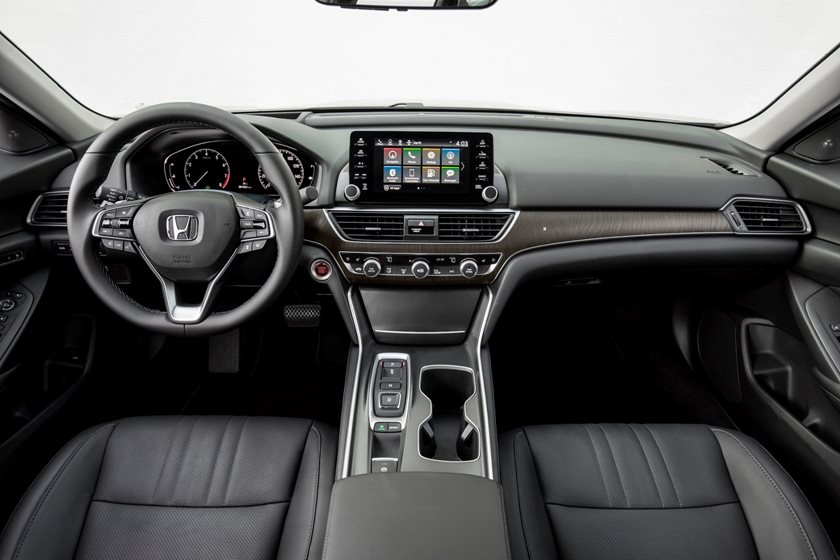

The reign of the Honda Accord began in 1976. It has been a leader in the midsize sedan market since then, with its excellence remaining constant. Yet, the Accord has changed a lot over the last four decades.
Take a look to see how the model has developed over the years!
The 1st Generation: 1976-1981

In 1976, Honda’s first Accord was a two-door hatchback. At the time, the Honda Accord was the brand’s premium model line above the Civic. It was powered by Honda’s second-generation 68-hp 1.6-liter CVCC four-cylinder engine. This made the Accord fuel-efficient, which was a key selling point during the oil crises of the 1970s.
Today, the Accord measures 192.5 inches in length. In contrast, the original ’77 Accord hatch was just 162.8 inches long. In 1979, Honda added a four-door sedan.
Second Generation: 1982-1985

Besides growing in size, the second-generation Accord is noteworthy for being assembled in the United States (the sedan model only), at a brand-new factory in Marysville, Ohio. It was the first Japanese car built in America. The Accord featured a four-cylinder engine that had 86 horsepower, by 1984. In 1985, Honda introduced the sportier Accord SEi with fuel injection, producing 101 horsepower under the hood.
With a boxier style, the Accord earned a spot on Car and Driver’s inaugural 10Best Cars list in 1983. The Accord would go on to be the winningest car in the award’s history.
Third Generation: 1986-1989

The third generation Accord grew in size, and with the redesigned sedan, hatchback, Honda added a slick coupe model for 1988.
Featuring a bolder design with their bladelike side profiles and sweet pop-up headlights, the cars drove as sporty as they looked.
Fourth Generation: 1990-1993

Building on the third generation, the fourth-generation Honda Accord showcased a low beltine, clean flanks, and an airy, well-proportioned roofline. The pop-up headlights were switched out to fixed units. According to Honda, they were “lower, wider, roomier, more powerful, and have a contemporary, international look.” This was also the first time the Accord qualified for a mid-size classification.
The Accord family consisted of the sedan, coupe, and a station wagon that replaced the hatchback. A 125-hp 2.2-liter SOHC four-cylinder engine was standard. A 130-hp engine was available on the EX trim, with the choice of a five-speed manual or four-speed automatic transmission.
Fifth Generation: 1994-1997

In this generation, Honda managed to create two milestones. The first was VTEC for the 2.2-liter four-cylinder engine, and later the V-6 that joined the lineup for the first time. The family once again consisted of the sedan, coupe, and wagon.
Sixth Generation: 1998-2002

The Accord wagon died with the fifth-generation, leaving behind the coupe and sedan body styles that continue today. A larger more powerful 135-hp 2.3-liter four-cylinder engine replaced the old 2.2-liter as the base engine. A 200-hp 3.0-liter V-6 took over for the previous-generation’s optional 2.7-liter V-6.
Seventh Generation: 2003-2007

In the seventh-generation Accord, Honda once again upped the outputs of the sedan’s four and six cylinder engines. Base models featured 160 horsepower from a 2.4-liter four, while the optional V-6 brought 240 horsepower to the party. Also for the first time, Honda paired the V-6 with a six-speed manual transmission in the coupe.
Eighth Generation: 2008-2012

Another growth spurt pushed the Accord into the EPA’s large-care size category. A coupe and sedan were both available, featuring aggressive styling, as well as an available 268 horsepower V-6 that could be linked to a six-speed manual.






Ninth Generation: 2013-2017

A heavy refresh of the eighth-generation model and a new Sport model of the sedan are the highlights of the ninth-generation Honda Accord. The Accord Hybrid also made a return in this generation.
Tenth Generation: Present-

The 2018 Honda Accord is available now! Check out the all-new and completely redesigned Accord at Manchester Honda, featuring the LX, Sport, EX, EX-L, and Touring trim levels




